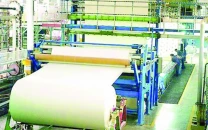Cabinet approves merger of printing firms
Green-lights appointment of three female members on PC board

The cabinet has approved the re-merger of National Security Printing Company, a state-owned enterprise, with Pakistan Security Printing Corporation, owned by the State Bank of Pakistan.
Earlier, the Cabinet Committee on State-owned Enterprises (CCOSOEs), in its meeting held on August 5, 2024, green-lighted the re-merger and later the issue was taken up by the cabinet.
Reviewing a summary submitted by the Cabinet Division, the cabinet ratified decisions pertaining to the re-merger of National Security Printing Company with Pakistan Security Printing Corporation. The cabinet also approved the appointment of three female members on the Privatisation Commission (PC) board, who would give their vital input for Pakistan's five-year sell-off programme.
The Privatisation Division stated that the Privatisation Commission was established as a corporate body under Section 3 of the Privatisation Commission Ordinance, 2000. Sections 6 and 7 of the ordinance govern affairs of the Privatisation Commission board, including the appointment and number of board members. According to Section 6(1), the general management and administration of the affairs of the Privatisation Commission shall vest in the board. The board shall consist of the chairman, secretary and six other members, or such other members, as may be determined by the federal government.
According to Section 7(1), the prime minister shall appoint the chairman, secretary and members of the commission.
The federal cabinet, in its decisions in two cases dated July 19, 2023 and August 3, 2023, determined that the number of board members should be eight with tenure of three years for new members. Accordingly, the prime minister appointed eight members, in terms of Section 7(1) of the ordinance, via notifications dated August 4, 2023, September 27, 2023 and June 28, 2024.
It was added that on the occasion of Women's Day 2024, the premier announced the Women Empowerment Package 2024, which emphasised that 33% women representation should be ensured on all federal boards, statutory bodies, public sector organisations and allied committees under the federal government, as per directives communicated by the Cabinet Division.
The Privatisation Division informed the meeting that at present only one female member was on the Privatisation Commission board, meaning women's representation comprised only 12.5%.
It was stated that to implement the prime minister's directive, a meeting was held on July 3, 2024 under the chairmanship of cabinet secretary, where it was reiterated that there should be 33% women representation on the board of the commission.
The cabinet was informed that the Privatisation Commission had formulated a five-year privatisation programme (2024-29) and some major transactions were at advanced stages. It was pointed out that board members were not only required to grant approvals at various stages of a transaction, but also to serve on transaction committees, evaluation committees, board committees, etc.
As a result, the workload of board members had increased considerably, thus requiring additional members. It was emphasised that an increase in the number of members would not only facilitate the effective execution of privatisation transactions but would also ensure 33% women representation on the Privatisation Commission board, in line with the PM's directive.
The division told the cabinet that the process of appointing three additional (female) members would be initiated, in terms of sub-section 1 of Section 7 of the Privatisation Commission Ordinance, 2000, pursuant to approval from the federal government.
The cabinet noted the suggestion of one of the members to add diversity of experience and ensure the inclusion of experts in relevant subjects.
Approval of the cabinet was solicited for the proposal. It reviewed the summary and approved the proposal with directives to ensure diversity of experience and include field experts.



















COMMENTS
Comments are moderated and generally will be posted if they are on-topic and not abusive.
For more information, please see our Comments FAQ